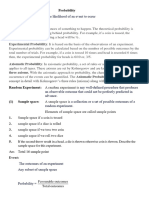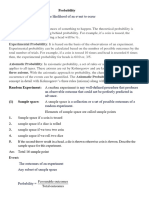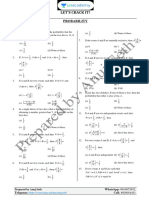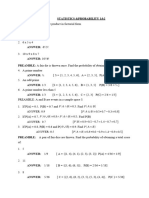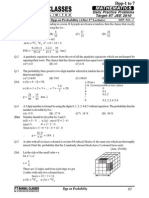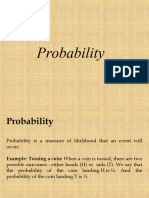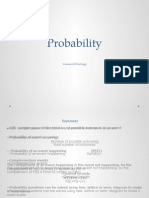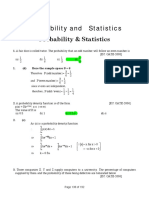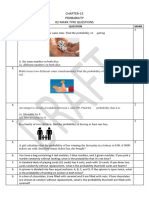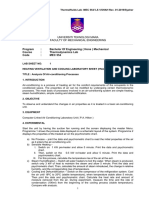COMPOUND PROBABILITY
Question & Answer
Question No. 1
A dice is thrown once. Find the probability of getting an even number or a number greater than
3.
Answer
There are two events, named event A and event B with the sample space on the toss of one
dice.
A = the occurrence of an even number.
B = the occurrence of a number greater than 3.
The data is as follows:
S = {1, 2, 3, 4, 5, 6}
n(S) = 6
A = {2, 4, 6}
n(A) = 3
so, the probability of event A is :
P (A) = n (A) / n(S) = 3 / 6
B = {4, 5, 6}
n(B) = 3
so, the probability of event B is :
P (B) = n(B) / n(S) = 3 / 6
It is obvious that there are two equal numbers from A and B, that are 4 and 6,
hence:
A ∩ B = {4, 6}
n(A ∩ B) = 2
So the probability of A ∩ B
P (A ∩ B) = n (A ∩ B) / n (S) = 2 / 6
The probability formula of "A or B"
P (A ∪ B) = P(A) + P(B) − P(A ∩ B)
= 3/6 + 3/6 − 2/6
= 4/6
= 2/3
Question No. 2
Two dices are thrown together at once. The probability that the total number of the two dices is
3 or 10 is.......
A. 2/36
1
�B. 3/36
C. 4/36
D. 5/36
D. 6/36
Answer
Two events in the toss of two dices, n(S) = 36,
A = the sum of the numbers is 3
B = the sum of the numbers is 10
From the sample space of throwing two dice, we get
A = {(1, 2), (2, 1)}
B = {(4, 6), (5, 5), (6, 4)}
n (A) = 2 → P(A) = 2/36
n (B) = 3 → P(B) = 3/36
There are not any same number occur between A and B, so n (A ∩B) = 0
So the probability of "A or B" is
P (A ∪ B) = P(A) + P(B)
= 2/36 + 3/36
= 5/36
Question No. 3
A bag contains 4 red balls, 3 white balls and 3 black balls. A ball is drawn at random, the
probability of getting a red or black ball is....
A. 4/5
B. 7/10
C. 3/6
D. 2/6
E. 1/10
Answer
The sum of all the balls in the bag is
4 + 3 + 3 = 10 balls. One ball is drawn from 10 balls.
A = occurrence of getting a red ball.
B = occurrence of getting a black ball.
There are 4 red balls, so the probability of getting a red ball is:
P(A) = 4/10
There are 3 black balls, so the probability of getting a black ball is:
P(B) = 3/10
Probability of drawing a red or black ball:
P(A∪B) = P(A) + P(B)
= 4/10 + 3/10
= 7/10
Note:
P (A ∪ B) = P(A) + P(B)
It is called a mutually exclusive events or events that can not happen at the same time.
2
�Question No. 4
In a group of 30 students, 10 people like math, 15 people like Physics and 5 people like both. If
one person is selected from the group, determine the probability of being selected:
a) students who like math and physics
b) students who like math or physics
Answer
A = event where the chosen like math
B = events where the chosen like physics
P(A) = 10/30
P(B) = 15/30
a) like math and physics
There are 5 students who like math and physics, out of 30 children
P(A∩B) = 5/30
b) like math or physics
P(A∪B) = P(A) + P(B) − P(A∩B)
= 10/30 + 15/30 − 5/30
= 20/30
Question No. 5
Box I contains 2 red balls and 3 white balls. Box II contains 5 red balls and 3 white balls. One
ball is taken from each Box. The probability that a red ball is drawn from Box I and a white ball
is drawn from Box II is....
A. 1/40
B. 3/20
C. 3/8
D. 2/5
E. 31/40
Answer
P(A) = probability of getting a red ball from Box I.
In Box I there are 2 red balls out of 5 balls in Box A. So the probability of getting a red ball from
Box I is
P(A) = 2/5
P(B) = Probability of getting a white ball from Box II.
In Box II there are 3 white balls out of 8 balls in Box II. So the probability of getting a white ball
from Box II is
P (B) = 3/8
The probability that a red ball is drawn from Box I and a white ball is drawn from Box II is
P(A∩B) = P(A) × P(B)
= 2/5 × 3/8
= 6/40
= 3/20
3
�The long explanation is as follows:
w1 w2 w3
R1 R2 W1 W2 W3 W
r1 r2 r3 r4 r5
Box II W 1 W W W
W
Box II
1 1 1 1 1
Box I Box II
Box II
The contents of Box I are 2 red, 3 white as follows:
R1, R2, W 1, W 2, W 3.
The contents of Box II are 5 red, 3 white as follows:
r1, r2, r3, r4, r5, w1, w2, w3
Determining the sample space.
The number of sample points is 40, so n(S) = 40. We get it from 5 x 8 = 40. The tree diagram if
necessary is as follows: W
R1, R2, W 1, W 2, W 3 in Box I and its pair in1 Box II:
Box I Box II
r1
r2
r3
r4
R1 r5 8
w1
w2
w3
r1
r2
r3
r4
R2 r5
w1
w2
w3
r1
r2
r3
r4
5 W1 r5
w1
w2
w3
r1
r2
r3
r4
W2 r5
w1
w2
w3
r1
r2
r3
r4
W3 r5
w1
w2
w3
4
�S ={(R1, r1), (R1, r2), (R1, r3), (R1, r4), (R1, r5), (R1, w1), (R1, w2), (R1, w3), (R2, w1),.................,
(W 3, w2), (W 3, w3) }
n(S) = 40
A = The occurrence a red ball is drawn from Box I.
A = {(R1, r1), (R1, r2), (R1, r3), (R1, r4), (R1, r5),(R1, w1), (R1, w2), (R1, w3), (R2, r1), (R2, r2),
(R2, r3), (R2, r4), (R2, r5),(R2, w1), (R2, w2), (R2, w3)}
n(A) = 16
hence, P(A) = 16/40
B = The occurrence a white ball is drawn from Box II.
B = {(R1, w1), (R1, w2), (R1, w3), (R2, w1), (R2, w2), (R2, w3), (W 1, w1), (W1, w2), (W 1, w3),
(W 2, w1), (W 2, w2), (W 2, w3), (W 3, w1), (W 3, w2), (W3, w3)}
n(B) = 15
hence, P(B) = 15/40
The intersection between A and B (the same one):
A ∩ B = {(R1, w1), (R1, w2), (R1, w3), (R2, w1), (R2, w2), (R2, w3}
n(A ∩ B ) = 6
hence, P(A ∩ B ) = 6/40 = 3/20
Note:
For
P (A ∩ B) = P(A) × P(B)
It's called an independent event.
Question No. 6
A dice and a coin are tossed once on the table. The probability of getting number five on the
dice and number on the coin is...
A. 1/24
B. 1/12
C. 1/8
D. 2/3
E. 5/6
Answer
A = The occurrence of number 5 appears on the throw of the dice.
Sample space for rolling the dice S = {1, 2, 3, 4, 5, 6}
We get
n(S) = 6
n(A) = 1
So, P(A) = 1/6
5
�B = the occurrence of number appearing on the toss of a coin.
Sample space for rolling the dice S = {N, P} with N = number, P = picture
n(S) = 2
n(B) = 1
So, P(B) = 1/2
The probability of getting number five on the dice and a number on the coin is thus:
P(A∩B) = P(A) × P(B)
= 1/6 × 1/2 = 1/12
Question No. 7
Basket A is containing 10 oranges, 2 of them are rotten, while basket B is containing 15
mangoes, 3 of them are rotten. Mother wants 5 oranges and 5 good mangoes, the probability
is....
A. 16/273
B. 26/273
C. 42/273
D. 48/273
E. 56/273
Answer
10 oranges in basket A, 2 oranges are rotten, 8 oranges are good.
15 mangoes in basket B, 3 mangoes are rotten, 12 mangoes are good.
2 rotten 3 rotten
8 good 12 good
10 oranges 15 mangoes
A : the occurrence that 5 good oranges are selected from basket A.
B : the occurrence that 5 good mangoes are selected from basket B.
Determine the probability of the event A
Taking 5 oranges from 10 oranges in basket A, produces as many ways (sample points) as
Meanwhile, taking 5 good oranges from 8 good oranges in basket A produces as many ways as
So the chance of getting 5 good oranges from basket A
Determine the probability of the event B
Taking 5 mangoes from 15 mangoes in basket B, produces as many ways as
6
�Meanwhile, taking 5 good mangoes from 12 good mangoes in basket A produces as many ways as
So the chance of getting 5 good mangoes from basket B
So the probability of getting 5 good oranges from basket A and 5 good mangoes from basket B is
